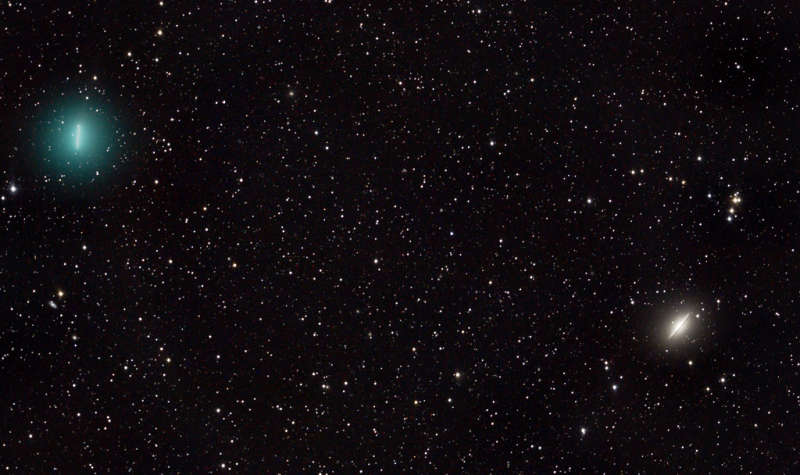Credit & Copyright: Ian Griffin (Otago Museum)
Explanation:
Comet Iwamoto (C/2018 Y1), shows off
a pretty, greenish coma at the upper left in this telescopic
field of view.
Taken on February 4 from the
Mount
John Observatory, University of Canterbury,
the 30 minute long total exposure time shows
the comet sweeping quickly across a background of stars and
distant galaxies in the constellation Virgo.
The long exposure and Iwamoto's
rapid
motion relative to the stars and galaxies results
in the noticeable blurred streak tracing the the comet's bright inner coma.
In fact, the streaked coma gives the comet
a remarkably similar appearance to Messier 104 at lower right,
popularly known as the Sombrero Galaxy.
The comet, a visitor to the inner Solar System, is a mere 4
light-minutes away though, while
majestic
Messier 104, a spiral galaxy posing edge-on,
is 30 million light-years distant.
The first
binocular comet of 2019,
Iwamoto will pass closest to Earth on February 12.
This comet's highly elliptical orbit around the Sun stretches beyond the
Kuiper belt
with an estimated 1,371 year orbital period.
That should bring it back to the inner Solar System in 3390 AD.
1999 2000 2001 2002 2003 2004 2005 2006 2007 2008 2009 2010 2011 2012 2013 2014 2015 2016 2017 2018 2019 2020 2021 2022 2023 2024 2025 |
Январь Февраль Март Апрель Май Июнь Июль Август Сентябрь Октябрь Ноябрь Декабрь |
NASA Web Site Statements, Warnings, and Disclaimers
NASA Official: Jay Norris. Specific rights apply.
A service of: LHEA at NASA / GSFC
& Michigan Tech. U.
|
Публикации с ключевыми словами:
comet - M 104 - кометы - галактика Сомбреро
Публикации со словами: comet - M 104 - кометы - галактика Сомбреро | |
См. также:
Все публикации на ту же тему >> | |
Мнения читателей [32]
